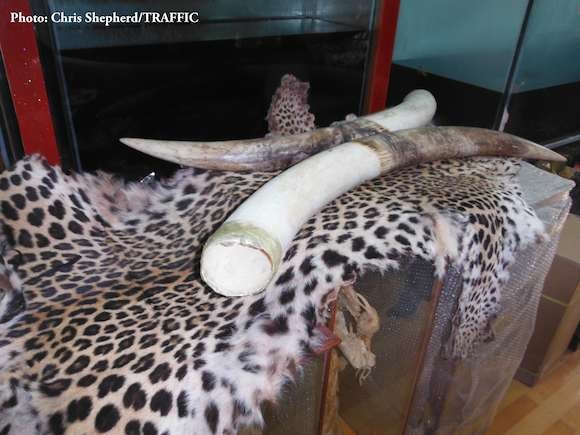- Recent surveys by WWF and TRAFFIC have identified 10 of the most widely trafficked animals in the Golden Triangle.
- These top 10 animals are: the tiger, elephant, pangolin, bear, rhinoceros, serow, helmeted hornbill, gaur, leopard, and turtles.
- The wildlife markets in the Golden Triangle cater mostly to tourists from China and Vietnam, the report noted.
Large casinos, hotels, shopping malls and markets flourish in Southeast Asia’s Golden Triangle — the area where Thailand, Laos, and Myanmar converge. These gambling halls and markets, known to be centers of prostitution and drug trafficking, have now emerged as hubs of wildlife trade.
From tiger skin and bones to skulls, forelegs and gall bladder of the goat-like serow, the Golden Triangle’s shops and hotels have become a haven for illegal wildlife products, according to recent surveys by WWF and TRAFFIC, the wildlife trade monitoring network.
Based on these surveys, the teams have identified 10 of the most widely trafficked animals in the Golden Triangle: the tiger, elephant, pangolin, bear, rhinoceros, serow, helmeted hornbill, gaur, leopard, and turtles.
“Bear farms and tiger farms, along with wide open wildlife markets across the Golden Triangle, are a menace to wild populations of these species and should be closed,” Bill Possiel, WWF-Greater Mekong regional conservation director, said in a statement. “This region has a deserved reputation as both a destination and source of some of the world’s most endangered species and that has to stop or these species could go extinct.”

The wildlife markets cater mostly to tourists from China and Vietnam, the survey teams noted in a report. Keen to consume wild animal parts, either in traditional medicines, food, or as symbols of wealth, these often-elite tourists travel to MongLa and Tachilek in Myanmar, and border areas like Boten and the Golden Triangle Special Economic Zone (GT SEZ) in Laos — a joint venture between a Chinese company called the Kings Romans Group, and the Laos government.
“Visitors [in GT SEZ] can openly buy endangered species products including tigers, leopards, elephants, rhinos, pangolins, helmeted hornbills, snakes and bears – smuggled in from Asia and Africa,” the Environmental Investigation Agency had reported in 2015. “Restaurants [offer] endangered species on their menus, from ”sauté tiger meat” and bear paws to reptiles and pangolins; one business kept a live python and a bear cub in cages, both of which were available to eat on request.”
Meet the top 10 most widely traded animals in the Golden Triangle:
1. Tiger
Tigers — both poached from the wild and captively farmed — are favorites in the Golden Triangle. Nearly every part of the tiger is on sale there, the report notes, either in the form of traditional medicine or as decoration, tiger wine or meat.
2. Elephant
Again, the survey teams found almost every part of elephant on sale in the region, including elephant teeth, hair, bones, tails, trunks, and ivory. Even elephant skin was available for consumption in restaurants as a cure for stomach ailments, the authors write. While much of the elephant ivory is thought to be smuggled from Africa, elephants in Myanmar are being poached, then skinned, to meet the demands of elephant skin.
3. Pangolin
Chinese and Vietnamese tourists in the Golden Triangle seek out pangolin meat, considered a delicacy, as well as pangolin scales, which are used in traditional medicine. International trade in all eight species of pangolins — four African and four Asian — is prohibited under international law.

4. Rhino
Most rhino products in the Golden Triangle are believed to have been smuggled from Africa. Rhino horns are, again, popular in traditional medicine, and are also bought as a symbol of wealth, particularly in Vietnam, according to the report.
5. Bear
The Golden Triangle region is home to bear farms, where bile is extracted from species like the Asiatic Black Bear and the Malaysian Sun Bear. The bile from their gall bladders is used in traditional medicine, and the bears’ paws are used to make soup. Many of these bear farms likely house bears that have been illegally captured from the wild, the report says.
6. Serow
The goat-like serow that lives in remote mountains across Asia is yet another commonly traded animal in the Golden Triangle’s markets. The survey teams found serow horns, skulls, forelegs, heads, gallbladders and medicinal oil on sale. The animal’s parts are especially prized in Laos traditional medicines.
7. Helmeted hornbill
This critically endangered bird has a solid bill casque that is extremely prized in China, where carved casques are used an ivory substitute. Chinese demand for these casques have led to a drastic decline in helmeted hornbill numbers, the report notes, especially in Indonesia.
8. Gaur
This wild species of cattle is being poached mostly for its majestic horns. Surveys of the markets of the Golden triangle revealed horns, gallbladders for medical purposes and whole heads as trophies, according to the report.
9. Leopard
Leopard products in the markets of the Golden Triangle range from entire skins to heads sold as trophy. The origin of these leopard parts are, however, difficult to pinpoint, the report says. Among the leopards on sale, the teams found that clouded leopards were being traded in particularly high numbers.
10. Turtle
The survey teams found numerous turtles and tortoises in the markets of the Golden Triangle being sold as live animals, decorative items and food. Some turtles on display included softshell turtles, Asian box turtles and impressed tortoises.
Banner image of Sumatran tiger by Rhett A. Butler.
